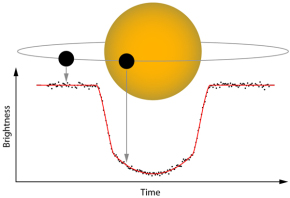A new camera called OPTIC (Orthogonal Parallel Transfer Imaging Camera), built at the University of Hawaii, has clarified our view of the distant world known as WASP-10b. Transits are helpful because they allow us to measure the size of the observed planets, and in this case, WASP-10b turns out to be not one of the most bloated exoplanets yet found, as once thought, but one of the densest. Orbiting some 300 light years from Earth, the planet’s diameter is now known to be only six percent larger than Jupiter’s, although it is three times more massive, with a corresponding density three times that of Jupiter.

OPTIC is mounted on the University of Hawaii’s 2.2-meter telescope on Mauna Kea. If you compare what it can do with its highly sensitive and stable detector to the best results from charge-coupled devices (CCDs), you find a photometric precision two to three times higher. According to this news release from the university’s Institute for Astronomy, that’s comparable to the most recent results from the Hubble Space Telescope for stars of the same brightness. Says team member Joshua Winn (MIT), “This new detector design is really going to change the way we study planets. It’s the killer app for planet transits.”
Image: When the planet WASP-10b crosses the disk of its star, WASP-10, the brightness of the star decreases, allowing scientists to measure the precise size of the planet. Credit: UH/IfA.
WASP-10 is a K-class star about 75 percent as massive as the Sun, one of only nine known low-mass planet host stars within 200 parsecs. More on the WASP-10b findings in Johnson et al., “A Smaller Radius for the Transiting Exoplanet WASP-10b,” available online.


its really wonderful to know that a university has produced such a great and useful piece of technology. Now a days it has became like a trend that new discoveries and inventions are very costly that one organization cannot produce any fruitful results…
WASP-12b: The hottest transiting planet yet discovered
Authors: L. Hebb, A. Collier-Cameron, B. Loeillet, D. Pollacco, G.Hébrard, R.A. Street, F. Bouchy, H.C. Stempels, C. Moutou, E. Simpson, S. Udry, Y.C. Yoshi, R.G. West, I.Skillen, D.M. Wilson, I. McDonald, N.P. Gibson, the SuperWasp Consortium
(Submitted on 17 Dec 2008 (v1), last revised 5 Jan 2009 (this version, v2))
Abstract: We report on the discovery of WASP-12b, a new transiting extrasolar planet with $R_{\rm pl}=1.79 \pm 0.09 R_J$ and $M_{\rm pl}=1.41 \pm 0.1 M_J$. The planet and host star properties were derived from a Monte Carlo Markov Chain analysis of the transit photometry and radial velocity data. Furthermore, by comparing the stellar spectrum with theoretical spectra and stellar evolution models, we determined that the host star is a super-solar metallicity ([M/H]$=0.3^{+0.05}_{-0.15}$), late-F (T$_{\rm eff}=6300^{+200}_{-100}$ K) star which is evolving off the zero age main sequence.
The planet has an equilibrium temperature of T$_{\rm eq}$=2516 K caused by its very short period orbit ($P=1.09$ days) around the hot, 12th magnitude host star.
WASP-12b has the largest radius of any transiting planet yet detected. It is also the most heavily irradiated and the shortest period planet in the literature.
Comments: This replaced version corrects typo in HJD0 of transit time
Subjects: Astrophysics (astro-ph)
Cite as: arXiv:0812.3240v2 [astro-ph]
Submission history
From: Leslie Hebb [view email]
[v1] Wed, 17 Dec 2008 10:30:30 GMT (365kb)
[v2] Mon, 5 Jan 2009 13:13:27 GMT (365kb)
http://arxiv.org/abs/0812.3240
WASP-16b: A new Jupiter-like planet transiting a southern solar analog
Authors: T. A. Lister, D. R. Anderson, M. Gillon, L. Hebb, B. S. Smalley, A. H. M. J. Triaud, A. Collier Cameron, D. M. Wilson, R. G. West, S. J. Bentley, D. J. Christian, R. Enoch, C. A. Haswell, C. Hellier, K. Horne, J. Irwin, Y. C. Joshi, S. R. Kane, M. Mayor, P. F. L. Maxted, A. J. Norton, N. Parley, F. Pepe, D. Pollacco, D. Queloz, R. Ryans, D. Segransan, I. Skillen, R. A. Street, I. Todd, S. Udry, P. J. Wheatley
(Submitted on 3 Aug 2009)
Abstract: We report the discovery from WASP-South of a new Jupiter-like extrasolar planet, WASP-16b, which transits its solar analog host star every 3.12 days.
Analysis of the transit photometry and radial velocity spectroscopic data leads to a planet with R_p = 1.008+-0.071 R_Jup and M_p =0.855+-0.059 M_Jup, orbiting a host star with R_* = 0.946+-0.054 R_sun and M_* = 1.022+-0.101 M_sun.
Comparison of the high resolution stellar spectrum with synthetic spectra and stellar evolution models indicates the host star is a near-solar metallicity ([Fe/H]= 0.01+-0.10) solar analog (Teff = 5700+-150 K, log g= 4.5+-0.2) of intermediate age (Tau = 2.3+5.8-2.2 Gyr).
Comments: 9 pages, 4 figures, accepted by ApJ
Subjects: Earth and Planetary Astrophysics (astro-ph.EP)
Cite as: arXiv:0908.0297v1 [astro-ph.EP]
Submission history
From: Tim Lister [view email]
[v1] Mon, 3 Aug 2009 16:53:20 GMT (103kb)
http://arxiv.org/abs/0908.0297